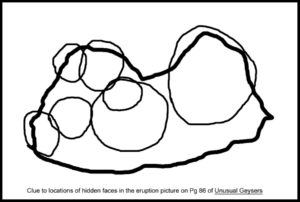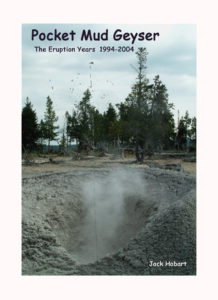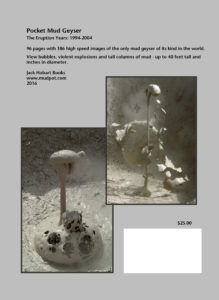Especially for the Icelandic geyser portion of this page, it can easily be translated into Icelandic using your browser with Google Translate, for example.
Look! What’s that Lurking in the Mudpots?
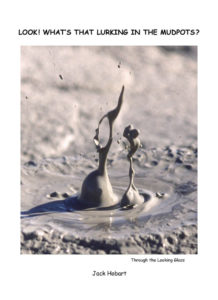 |
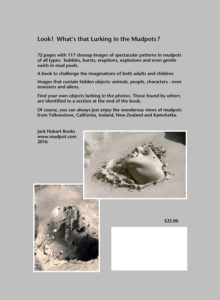 |
||
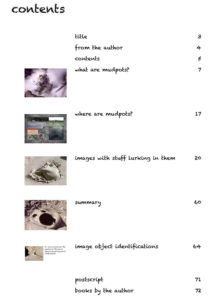 |
High speed close-up photos of mudpot bursts, primarily in Yellowstone National Park. These complex bursts contain hidden shapes to challenge the imaginations of both adults and children. You can find objects hiding in the pictures, then compare yours with what others have found. Their findings are revealed starting at Page 64. This is the first book published about mudpots of Yellowstone and other geothermal regions across the globe. Their forms are described in detail for the first time, including examples from Yellowstone, Iceland, California, New Zealand and distant Kamchatka in Siberia, Russia. Emphasis is on closeup photography at high shutter speeds to freeze the action like rarely seen up to now. By showing the most compelling patterns from 35 years of mudpot photography, the pictures turn into fascinating challenges for inquiring minds to solve. A special note about the remarkable image on Page 63. After the book was printed, it was noted that the mudpot image also has hands over his ears and a shirt collar, just like in the painting! If this makes you more uneasy, you can always follow the suggestion on that page .
(click on any image to enlarge it and see detail) softbound, 72 pages, 117 closeup images: $25. Order from the Shopping Cart page |
||
Additional Mudpot Objects Found:
- Pg 6; A ghostly face formed by the shadow at lower right.
- Pg 11: A small, cute animal head in the lower left image.
- Pg 63: Note also that the mudpot scream face has what looks like hands covering his ears, just like in the painting. Also, he has a vee-shaped collar like in the painting.
About the Remarkable Painting: The Scream on Page 63:
An interesting TV show about this painting was presented in the series, Raiders of the Lost Art, on the Ovation Channel, season 2, episode 1, titled “Stealing the Scream”. It is also available on Netflix.
Corrections and Additions:
Page 7, next to last paragraph: add after the word fluid: “(low viscosity)”
A special note for those with Norwegian ancestry: Be sure to checkout Page 63, for it pays homage to Norway’s most significant art treasure.
Unusual Geysers
Corrections and Additions:
Page 112: The upper picture is referred to have an “animal” shape. Further research has uncovered a remarkable likeness to the early logo for RCA, its dog listening to an early phonograph, the “Victrola” (click to enlarge):
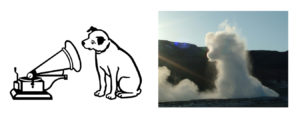
Page 132, first caption: Ignore the next to last sentence, starting with “Consequently”. It’s confusing.
Bubble Geyser Eruption Example:
A typical Botryoidal Spring eruption sequence of 10 images follows. They were taken about 0.2 seconds apart and show early water rise in a quiet spring followed by doming of water into a blue bubble with a textured surface pattern, then breaking apart into a normal spray eruption. You can click on the page to enlarge it, then enlarge the view to fill your computer screen (Command + on a Mac)
On a 55″ 4K TV screen, I was able to enlarge each picture in the sequence to 3 feet across with the same sharpness as the sequences in the Unusual Geysers book !
Challenges for Readers:
Page 48: There is an image of a woman in the eruption closeup. She appears to have an early pioneer hair style. There is a larger face with goggly eyes lurking above. In the center, a smaller head with brimmed cap and large nose is more well-hidden.
The picture on Pg 86 has at least 7 heads “lurking” in the eruption, just like objects in the mudpot book. Fans of the Rolling Stones Steel Wheels tour will instantly recognize one of them. An outline sketch below indicates the approximate location and size of each head. Three more were found during the preparation of this sketch. No more hints.
Books Not Yet in Print
More Things that Lurk in Mudpots
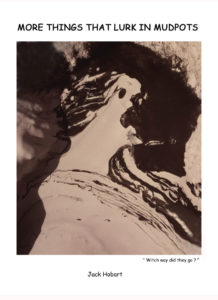 |
A sequel to Look! What’s that Lurking in the Mudpots? Another collection of the fun images suitable for readers to look for hidden objects within the closeup high speed photos of mudpot bursts. |
||
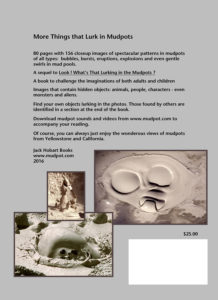 |
|||
Pocket Mud Geyser

















